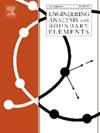A meshless Runge-Kutta-based Physics-Informed Neural Network framework for structural vibration analysis
IF 4.2
2区 工程技术
Q1 ENGINEERING, MULTIDISCIPLINARY
Engineering Analysis with Boundary Elements
Pub Date : 2025-01-01
DOI:10.1016/j.enganabound.2024.106054
引用次数: 0
Abstract
In recent years, Physics-Informed Neural Networks (PINN) have emerged as powerful meshless numerical methods for solving partial differential equations (PDEs) in engineering and science, including the field of structural vibration. However, PINN struggles due to the spectral bias when the target PDEs exhibit high-frequency features. In this work, a meshless Runge-Kutta-based PINN (R-KPINN) framework for structural vibration modelling is proposed for the first time. In the framework, the meshless features of traditional PINN are retained while applying Runge-Kutta (R-K) time integration to discretise the temporal domain, thereby reducing computational demands and enhancing temporal flexibility. Besides, the proposed R-KPINN allows for segmental training of PINN, reducing the dimensionality of the structural vibration problems and offering accurate solutions to relatively high-frequency functions. Through numerical examples including free, damped, and forced vibration of Euler-Bernoulli beams, the proposed framework provides effective and precise solutions for predicting the responses of structures. In summary, the proposed R-KPINN framework provides a flexible, efficient, and interpretable meshless method for solving structural vibration problems with state-of-the-art PINN techniques.
结构振动分析的无网格龙格-库塔神经网络框架
近年来,物理信息神经网络(PINN)作为求解偏微分方程(PDEs)的无网格数值方法在工程和科学领域(包括结构振动领域)得到了广泛应用。然而,当目标pde表现出高频特征时,由于光谱偏置,PINN会遇到困难。在这项工作中,首次提出了一种基于无网格龙格-库塔的结构振动模型(R-KPINN)框架。该框架在保留传统PINN的无网格特征的同时,采用龙格-库塔(R-K)时间积分对时域进行离散化,从而减少了计算量,增强了时间灵活性。此外,所提出的R-KPINN允许对PINN进行分段训练,降低结构振动问题的维数,并为相对高频的函数提供准确的解。通过欧拉-伯努利梁的自由振动、阻尼振动和强迫振动的数值算例,该框架为预测结构的响应提供了有效和精确的解决方案。总之,所提出的R-KPINN框架提供了一种灵活、高效和可解释的无网格方法,用于使用最先进的PINN技术解决结构振动问题。
本文章由计算机程序翻译,如有差异,请以英文原文为准。
求助全文
约1分钟内获得全文
求助全文
来源期刊

Engineering Analysis with Boundary Elements
工程技术-工程:综合
CiteScore
5.50
自引率
18.20%
发文量
368
审稿时长
56 days
期刊介绍:
This journal is specifically dedicated to the dissemination of the latest developments of new engineering analysis techniques using boundary elements and other mesh reduction methods.
Boundary element (BEM) and mesh reduction methods (MRM) are very active areas of research with the techniques being applied to solve increasingly complex problems. The journal stresses the importance of these applications as well as their computational aspects, reliability and robustness.
The main criteria for publication will be the originality of the work being reported, its potential usefulness and applications of the methods to new fields.
In addition to regular issues, the journal publishes a series of special issues dealing with specific areas of current research.
The journal has, for many years, provided a channel of communication between academics and industrial researchers working in mesh reduction methods
Fields Covered:
• Boundary Element Methods (BEM)
• Mesh Reduction Methods (MRM)
• Meshless Methods
• Integral Equations
• Applications of BEM/MRM in Engineering
• Numerical Methods related to BEM/MRM
• Computational Techniques
• Combination of Different Methods
• Advanced Formulations.
 求助内容:
求助内容: 应助结果提醒方式:
应助结果提醒方式:


